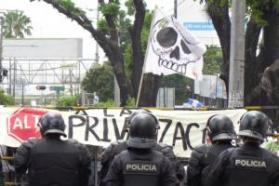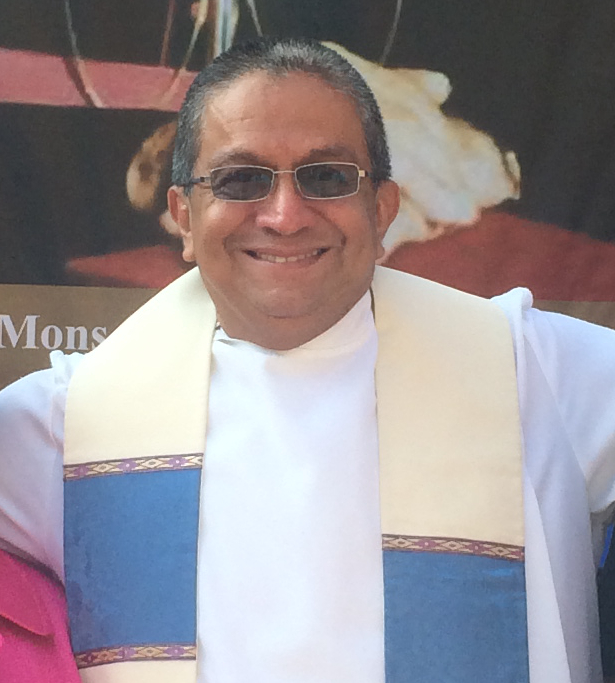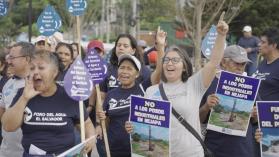Reflections of a Social Work Student on Witnessing Healthcare Reform in El Salvador
by Rachel Bedick, participant in 2012 Medical Brigade Originally published in the Field Journal (Simmons School of Social Work) In August 2012, I participated in a two-week medical brigade to El Salvador, organized by the Committee in Solidarity with the People of El Salvador (CISPES). Before I began working towards my MSW, I worked as a community organizer with public housing tenants in Somerville, a low-income community outside Boston; this work shaped the way I think critically about institutions, inequality, and social change. My desire to combine individual clinical work and community organizing work with Spanish-speaking immigrants led me to social work school. I was curious to see how El Salvador, one of the poorest countries in the world, uses its limited resources to simultaneously attend to individuals’ needs and make structural changes. My first-year field placement was at a Boston public elementary school, where I worked with many children and families from Central America. This was a setting where I was constantly forced to think about the ties between individual issues and structural inequalities. For instance, school buses consistently arrived thirty minutes late, with the result that students, who were mainly low-income and of color, were cumulatively losing days of their education. Another example of tension between individual needs and structural issues came up when I was working with an undocumented Guatemalan family. After we had worked together for a month, the family abruptly decided to move across the country because they were afraid of being deported due to the implementation of Secure Communities. Secure Communities is a Homeland Security policy that allows police officers to communicate directly with Immigration and Customs Enforcement (ICE) regarding people’s immigration status. After being trailed by a police officer, the family got frightened and decided to move out of state, without time for us to officially terminate. At the end of my first-year field placement, I knew that my second-year placement would be at the outpatient mental health department of Massachusetts General Hospital (MGH) in Chelsea, MA. Chelsea has a population of 34,532 people, of which 62.1% identify as Latino (State and County, 2012). Chelsea is one of the poorest towns in Massachusetts and is filled with immigrants, many of whom are Salvadoran. Between Chelsea and Revere, a neighboring town that also utilizes the MGH Chelsea Health Center, 13,475 are Salvadoran (Granberry & Rustan, 2010). Knowing that I would probably work with many Salvadoran clients, I wanted to learn more about the country’s political context in order to be a more culturally competent and responsive clinician. I had been to El Salvador once before, in 2007, when I participated in a service-learning trip with the American Jewish World Service (AJWS). I began to learn some of El Salvador’s history while meeting with government officials on the medical brigade. In the 1980s, in an effort to stave off Communism, the U.S. funded the right-wing dictatorship in El Salvador that was responsible for major government repression and death squads. In response, Socialist and Communist groups banded together to form the Farabundo Marti National Liberation Front (FMLN) and took up arms in the mountains to resist the dictatorship. In 1980, CISPES was created in the U.S. by collaboration between Salvadoran refugees and activists in the U.S., whose shared goal was to stop U.S. intervention in El Salvador. At that time the U.S. was providing $1,000,000 a day to the Salvadoran government. The civil war lasted from 1980 to1992, when peace accords were signed, due to a stalemate between the Salvadoran government and the FMLN guerillas. As a stipulation of the peace accords, the FMLN successfully transitioned into a legitimate political party. From 1992 to 2009, ARENA (National Republic Alliance), a right-wing party in El Salvador directly linked to the death squads during the civil war, continued to win elections and hold power. In 2009, however, Mauricio Funes ran under the banner of the FMLN and was elected to the presidency. The FMLN-led government is committed to building social programs to provide a strong public health and educational infrastructure. Influenced by the Cuban health care model, this vision includes strong preventative and primary health care, coordinated care, and an emphasis on community engagement. The Ministry of Health designed a system that values healthcare as a basic human right that is accessible and free to everyone. The system is three-tiered and includes basic primary clinics all over the country, regional hospitals, and third-level hospitals, of which there are three in the capital, San Salvador: the Maternity Hospital, the Children’s Hospital, and a General Hospital. Since prevention is a major facet of this reformed health care system, the first level of the national public health care system are the ECOS, or Equipos Comunitarios de Salud (Community Health Teams), which are comprised of a doctor, a nurse, an assistant nurse, a “jack of all trades,” and three health promoters. The brigadistas and I visited four different ECOS in La Palma and the small towns of Granadillas, Horcones, and San José Zacare, all in the department of Chalatenango, which sits near El Salvador’s border with Honduras. Many of the doctors who work at these rural clinics are placed there as part of a required year of service after completing medical school. Due to the healthcare reform, these clinics that house the ECOS are now staffed on weekdays with a doctor. In the past, the doctor made visits to these remote clinics infrequently. The majority of the health promoters we met are from the communities in which they work. Several of them had been working as health promoters for the past ten years. Prior to the healthcare reform, health promoters were funded by NGOs, but they are now under the auspices of the Ministry of Health. Although the ECOS we saw in La Palma and the surrounding areas did not include social workers, the health promoters utilized social work tools while providing care. Each health promoter was responsible for making house visits to approximately 200 families. Depending on people’s health risk factors, the health promoters would visit at least once, if not multiple times a year. When meeting with individuals and families, health promoters used a genogram to organize family histories. They surveyed the environment of the house and asked about garbage disposal, composting, and how often families cleaned the outdoor sinks in order to diminish the breeding of mosquitoes. The health promoters walked long distances over mountains carrying heavy backpacks full of supplies, not knowing what medical needs they would find upon entering a home. They had to be resourceful and responsive to the presenting needs; for example, when they didn’t have plastic gloves to administer disinfectant to a wound, they used a plastic bag. I was impressed by the compassion and care shown by the health promoters. One health promoter showed tact and respect as he encouraged a mother to explain puberty, menstruation, and safe sex to her preadolescent daughter. The health promoters were knowledgeable and creative, and had to be ready for anything. Another function of the ECOS was to organize monthly health clubs for Salvadorans to learn about various health topics. The fellow brigadistas and I gave workshops to these clubs on infant nutrition, healthy relationships for teenagers, family planning for pregnant women, and healthy aging for elders. Some Salvadorans walked for an hour to attend these meetings. It was inspiring to see the commitment that community members had to taking responsibility for their health and the health of their communities. The brigade did get to hear about one of the seven community mental health teams being implemented as part of the health care reform. The team is comprised of a social worker, a psychologist, a psychiatrist, and a visual artist. Distrita Italia, a town outside of San Salvador, has lost many adults who leave looking for better economic opportunity. The town also has major gang problems. In a needs assessment, the mental health team identified violence as the number one problem in Distrita Italia, and began to plan interventions with community members, including gang members. They developed children’s groups to help young Salvadorans process losses they experience and violence they see in their families and communities. Through art projects, including public murals, the community mental health team provided an outlet for young people to express their feelings. The health care reform is just one of many social programs being implemented by the FMLN-led government. Another impressive program is the “School Packet” program. The government is providing every school-aged child with a pair of shoes, a uniform, a notebook, a glass of milk, and lunch. All of these products are manufactured in El Salvador, stimulating job growth. The continuation of these programs depends on the election in 2014 of a government supportive of the FLMN, and there is no guarantee that will come to pass. My summer visit taught me about the political and social context of El Salvador, which will help me to be more culturally responsive when working with Salvadoran clients. I aspire to practice social work with the same respect and care and lack of cynicism I saw in the health promoters. No matter how many miles they had hiked through the mountains to make a house visit, I saw each health promoter treat his/her clients with focused attention and a smile. My trip to El Salvador is a clear reminder of how individual needs and structural inequality are intertwined. The NASW Code of Ethics demands that we as social workers both attempt to improve the immediate reality of individuals and work towards long-term social change that will address the root causes of our society’s problems (NASW, 2008). Long-term social change takes time, commitment, and perseverance. The Salvadoran people have been struggling for many decades, and have confronted tremendous violence and injustice, and yet they continue the struggle. Learning about the history of the U.S.’s involvement in El Salvador and the subsequent dismantling of the economy from neo-liberal policies, such as the Central American Free Trade Agreement (CAFTA), is upsetting. Even more heartbreaking is the psychological impact on the families who are separated by immigration, many of whom utilize the mental health clinic at MGH in Chelsea. As I finish my last year of social work school, I intend to prioritize being engaged with social justice work related to immigration. Author’s Note: If you are interested in learning more about issues in El Salvador, CISPES has local chapters around the country–contact [email protected] to find one near you; and visit www.cispes.org for the latest news and human rights updates. The CISPES 2012 Medical Brigade Report is also available as a PDF. Granberry, P., and Rustan, S. (2010). Latinos in Massachusetts selected areas: Chelsea, Revere, and Winthrop. Gastón Institute Publications. Retrieved from http://scholarworks.umb.edu/gaston_pubs/39 National Association of Social Workers. (2008). NASW code of ethics. Retrieved from http://www.naswdc.org/pubs/code/code.asp U.S. Department of Commerce, United States Census Bureau. (2012). State and county quickfacts: Chelsea (city), Massachusetts. Retrieved from http://quickfacts.census.gov/qfd/states/25/2513205lk.html

 "I am a CISPES supporter because continuing to fight for social justice and a more people-centered country means continuing the dream and sacrifice of thousands of my fellow Salvadorans who died for that vision.” - Padre Carlos, New York City
"I am a CISPES supporter because continuing to fight for social justice and a more people-centered country means continuing the dream and sacrifice of thousands of my fellow Salvadorans who died for that vision.” - Padre Carlos, New York City

